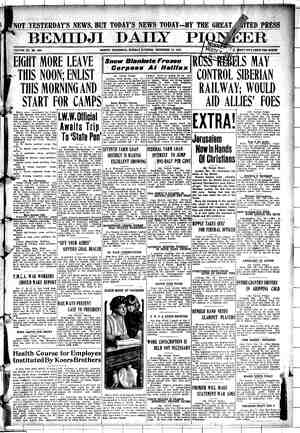The Nonpartisan Leader Newspaper, December 10, 1917, Page 7
You have reached the hourly page view limit. Unlock higher limit to our entire archive!
Subscribers enjoy higher page view limit, downloads, and exclusive features.
L= ] - The importance of President Townley’s speech to organized labor nt'Buflulé, N. Y., was realized by the independent pape ~: This is Erésident Townley’s speech to organized labor of the United Stafes, given at the national convention of the American Federation of Labor at Buffalo, N. Y. To the interests that are fight- | Ing to keep the farmers and the organized working men from co-operating politically and - economically this speech is like a red flag to a bull. % A Keep posted on important events. Read this. v %% N/ R —Drawn by Congressman John M. Baer rs of the East, which published extended accounts of it, and in addition several of the biggest and most influential Eastern papers published the above cartoon by Congressman Baer. Drawing cartoons for the Leader as well as attending to his work as farmers' congressman keeps Baer pretty busy. But occasionally he finds time to draw a cartoon for the Eastern papers, and this is one of that kind. Aside from his work ‘in congress, Baer is doing a tremendous work for the farmers by carrying the message of the Nonpar- tisan league to Eastern people. In this cartoon he depicts the organized farmer and the organized working man shaking hands, and the enemies of both of themr realizing what this means, scampering away. price you are payir{g we would make $55,000,000 more out of our wheat crop. That would be about $1,200 for every farmer in North Dakota, and -that is, the surplus that gets away from us. We don't propose, however, to charge you as much for the flour if we ever get to the place where we can sell it as the other fellow charges you now. So we went about it to bui.d in the state “of North Dakota a farmers’ organiza- tion for the purpose of establishing flour mills and elevators and handling our own wheat. We propose to do that through the operation of state-owned flour mills and elevators because our experience and investigation showed us that they would “cut the mustard,” and we haven't been able to do it in any other way. We have been trying to establish them by co-operative stock sale operations, but for some reason or other the flour trust invariably puts our mills out of business. We looked around to see what had been accomplished in the way of pub- licly owned institutions and on the west coast in the county where Seattle is.located we found there a publicly owned warehouse and wharf, &nd we found them saving the farmers a tre- mendous amount of money. ‘ The privately owned wharfs and-elevators were charging 60 cents a ton for wharfage and were paying labor 382 cents an hour, After the county put in a publicly owned elevator and whart the publicly owned institution paid: labor: 50 cents an hour and charged 20 cents a ton for wharfage and paid ex- penses. It was not a policy of this pub- licly owned institution or the peopls there to charge the consumer all they had been paying before, but the pur- pose was to divide “fifty-! Ao WHAT THE NORTH DAKOTA FARMERS DID And so we set about building an .or- ganization; we got 40,000 farmers in " the state of North Dakota into one or- ganization, Democrats, Republicans, Socialists, Bull-Moosers and every- thing else,and at the first election the farmers and their friends in the state of North Dakota elected everything from governor down to dog-catcher; and I want to say to you in passing that we had the full co-operation of organized labor in the state of North Dakota and still have it. The farmers and organized workers out there stand shoulder ‘to shoulder for the control of the state of North Dakota for ' the benefit of the workers in the cities and on the farms. The same thing is taking place in Minnesota, South Da- kota and in Montana, where we are pretty fully organized.- ; Last year we raised a very. poor grade of wheat; the elevator men and flour trust called it “feed D" wheat; they called it chicken feed. We have * an experimental mill at the college in North Dakota where Professor Ladd PAGE SEVEN has been grinding up this wheat to see whether it would make flour or not. He has ground wup 75 samples of this poor grade of wheat and he finds that 60 pounds of this grade will make as much as 60 pounds of No. 1 Northern, except about two or three pounds. When we were selling that wheat the milling trust paid us about 60 cents a bushel. The price of flour was based upon No. 1 Northern at $1.75 or $1.80 a bushel plus a good round profit, and those who had to admit that they made flour out of this poor grade wheat said the flour wasn't any good, but we caught them at that, too. The profes- sor not only grinds wheat into flour, but he bakes the flour into bread, and he tests it by every physical and chemical process known. Through scores of tests he showed that this made just as good bread as the flour made out of No. 1 Northern. After the millers . had gobbled up all our poor ‘Continued on page 17) iz e A D (N S i L S - A AR






